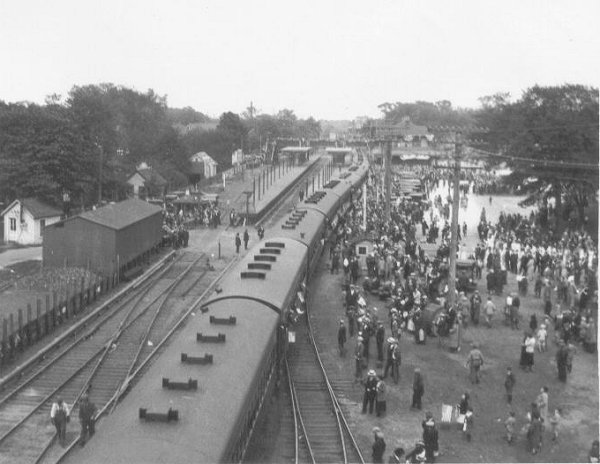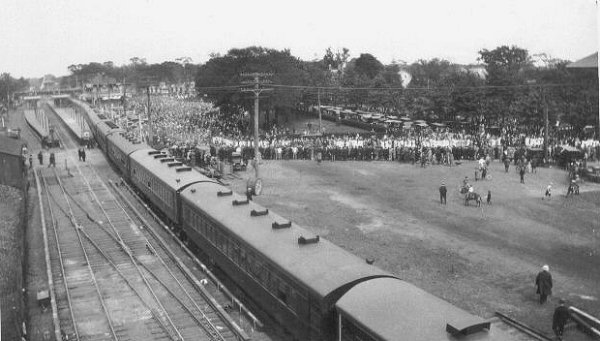OK . . .
A little research and this is what I turned up:
Storage battery cars ran part-way up the Mineola-Hempstead Crossing line and down to West Hempstead. This line was known as the New York Bay Extension and later the West Hempstead branch.
The ex-Ocean electric trolley cars ran out to Salisbury between 1915 and 1933, when MP41s took over the job.
Electrification was completed between Valley Stream and Mineola in 1926 and at that time, scheduled MU service began.
Per Art Huneke's website, Employee timetable #104, effective 5/19/26 shows regularly scheduled MU service as train #s 940, 942, 944, 948, 952, 956, 958, 960, 962, 964 and 966 leaving Valley Stream and arriving at Mineola, 7.3 miles distant. They returned as odd-numbered trains.
Art mentions that a typical example of MU thru-service was train #958, leaving Flatbush Avenue at 4:27pm, hitting Valley Stream at 5:02 pm and arriving Mineola at 5:22 pm. This equipment returned as train #959, reversing direction and continuing back through West Hempstead, Valley Stream and on to Penn Station.
Quite substantial passenger thru-service!!!
Dave Keller
Railroad Forums
DM30 and DE30
- Discussion of the past and present operations of the Long Island Rail Road.
Moderator: Liquidcamphor
by thrdkilr
What I find fascinating is that 75 years ago, when the population must have been a fraction of what it is now, they had all these trolleys, battery cars, and ping pongs servicing all these places and now there is very little intra-island rail service. What made them go away? Cars and buses I guess, seems a shame though, it would seem if the rail services could have hung tough, they could be doing pretty well now....
by Dave Keller
Cars, buses and the highway system killed the passenger trains.
Trucks killed the freight service.
Where one time people were content with waiting for the train to take them to Jamaica to shop, they now became impatient when they saw the convenience of their own car.
Also, buses stopped at most corners. The train did not.
The trolleys were fine except Mayor LaGuardia did his damndest to get rid of them. He had a vendetta against them and the ELs and he made both disappear.
The local trolleys were put out of business by the "Jitneys" which were buses who charged a nickel for a fare. (An old expression for a nickel was a "jit.")
Dave Keller
Trucks killed the freight service.
Where one time people were content with waiting for the train to take them to Jamaica to shop, they now became impatient when they saw the convenience of their own car.
Also, buses stopped at most corners. The train did not.
The trolleys were fine except Mayor LaGuardia did his damndest to get rid of them. He had a vendetta against them and the ELs and he made both disappear.
The local trolleys were put out of business by the "Jitneys" which were buses who charged a nickel for a fare. (An old expression for a nickel was a "jit.")
Dave Keller
by Nasadowsk
If you've ever seen the pictures of the opening of the babylon electrification, it's pretty neat - horse drawn carriages all surrounding a set of MP-54s.
I suppose it was quite a shock to the average farmer seeing an electric train - remember, there wasn't much radio in the mid 20's, homes out there likely didn't have electric power, etc.
Then again, I love the early pics of the m-1s, too. They must have looked downright futuristic in the late 60's - and even today they've got a nice look too them.
I suppose it was quite a shock to the average farmer seeing an electric train - remember, there wasn't much radio in the mid 20's, homes out there likely didn't have electric power, etc.
Then again, I love the early pics of the m-1s, too. They must have looked downright futuristic in the late 60's - and even today they've got a nice look too them.
by Dave Keller
1st MU train to Babylon:

and:

Dave Keller

and:

Dave Keller
by RPM2Night
Dave Keller wrote:Cars, buses and the highway system killed the passenger trains.So instead of waiting for a train, and getting there stress free, they have to wait in congested highways, battle the traffic on the streets near the shopping areas, and drive around searching for a parking spot. It probably takes longer that way than it would have by train...unless you live out a little deeper in suffolk. But then once they pass the light traffic in Suffolk and Eastern Nassau then they still get to wait in that traffic once they start getting closer to mid Nassau. Haha
Where one time people were content with waiting for the train to take them to Jamaica to shop, they now became impatient when they saw the convenience of their own car.
by RPM2Night
Frank wrote:I think it would be a good idea in the long run to electrify the Oyster Bay Branch.I wonder what the odds of that happening are. In my opinion they are pretty slim. The OB Branch is catered to the DE DM trains, and future diesel trains as well. Lots of the stations are too short to accomidate the long MU trains. Plus, you have that nice facility at the end of the line set up for the diesels...and that was a fairly recent renovation to the yard so that would pretty much nullify the money they already spent on the yard.
On the flip side, I'm sure that the residents that live along the branch would love to have more electric and less of the DEs and DMs simply because of the noise they produce. What's the fastest the trains go on the Oyster Bay Branch, 45 mph? And that only peaks in certain spots...so with the MU trains cruising through relatively slowly the only noise you'd really hear would be a minimal amount of wheel squeal and clanking.
Is this mostly what contributed to the Garden City secondary being shut down, or was it traffic disruption too? Seems kinda silly to me. Say it's passenger service, the trains don't hold up traffic for that long....just quick pass across the grade crossing.
by Frank
RPM2Night wrote:Why was the Graden City secondary shut down?Frank wrote: Is this mostly what contributed to the Garden City secondary being shut down, or was it traffic disruption too? Seems kinda silly to me. Say it's passenger service, the trains don't hold up traffic for that long....just quick pass across the grade crossing.
Rails are better than roads!
by thrdkilr
Great Pictures Dave, thankyou! I don't know where this Garden City hates the LIRR got started, it not true. What other town on the Island 5 different rail line (60's), 5 stations. I know for fact that if the LIRR had made Clinton ave station a regular station with servive to N.Y. the people who live north and southeast of there would have loved it, its a hell of lot closer to them than Country Life Press. What killed the secondary was the disapearence of the customers. Mitchell field was dead long before they closed it in 60's, Bronze was bought out by Gruman (who employees came from eastern LI), Newsday moved, the A&P went belly up (they were the 3 biggest cust.), rail service accross Meodowbrook never materialized for the most part. I remember the racetrains in the 60's(after the MU's were gone) used to come through Washington & Clinton going a hell of lot faster than the frieghts or MU's. Don't forget the terrible service LIRR frieght used to be known for ....
by mjb777
For those interested in knowing train#615 which leaves Port Jefferson at 7:35 starts out in D mode after it stops in Hicksville at 8:41 and I board it . the switch from D to E happens just after the Urban Ave crossing in Westbury and stays that way into Penn also train #2778 to Patchoque as pulled into Mineola with 500 Series engines in E mode and have stayed that way through Hicksville. I hope this answers some Questions
by RC '75
Hi,
I have a couple of questions regarding the DE30's/DM30's.
Are any DE/DM's used as push-pull on the LIRR?
I've seen pictures of a consist of C3's without a DE/DM attached. Can C3's run this way? If so, what lines do they run on?
At the very front of all DE/DM's, above the engineer doors are two small blue lights. I think there may also be one on each side, near the rear of the locomotive. Does anyone know what these lights signify?
When a consist of C3's are running alone, the head and rear car also have a blue light on the sides. Do these lights signify the same as on the DE/DM's?
Thank you...
I have a couple of questions regarding the DE30's/DM30's.
Are any DE/DM's used as push-pull on the LIRR?
I've seen pictures of a consist of C3's without a DE/DM attached. Can C3's run this way? If so, what lines do they run on?
At the very front of all DE/DM's, above the engineer doors are two small blue lights. I think there may also be one on each side, near the rear of the locomotive. Does anyone know what these lights signify?
When a consist of C3's are running alone, the head and rear car also have a blue light on the sides. Do these lights signify the same as on the DE/DM's?
Thank you...
by M1 9147
No C3 runs without an engine in its consist. The engine in push-pull mode is always on the east end except for DM runs to Penn, and an occasional push-pull run without a C-R cab, or a C-R cab that broke down during a run, then a west engine is used on top of an east engine. The blue or green lights found in either the loco, or the C-R cab is the ATC (Automatic Traction Control) light basically indicating that it is on, and active.